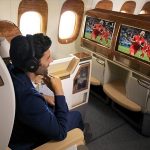Increased demand for in-flight connectivity will be used by satellite operators to justify building new systems, such as HTS (High Throughput Satellites) and S band services.
 In-flight entertainment and connectivity revenues are slated to double from 2018, exceeding $8.4 billion by 2023.
In-flight entertainment and connectivity revenues are slated to double from 2018, exceeding $8.4 billion by 2023.
A new study from Juniper Research found that increasing adoption of in-flight entertainment and connectivity systems by airlines and private aircraft operators will drive annual service revenues from an estimated $3.7 billion in 2018 to more than $8.4 billion by 2023.
The research found that systems installation by Low Cost Carriers is a driving force behind this growth. In an extremely competitive environment, commercial airlines such as easyJet are utilising these systems to differentiate the passenger experience.
The new research titled: In-Flight Entertainment & Connectivity: Technologies, Business Models & Key Vendors 2018-2023 found that airlines are increasingly adopting wireless streaming to passenger devices, with penetration in commercial aircraft in West Europe reaching 31% by 2023, up from 23% in 2018.
Juniper foresees that the greater cost efficiency of these systems, compared with seatback systems, will enable the increased Low Cost Carrier deployment. Offering entertainment services in the budget segment removes a crucial differentiator for more traditional airlines, meaning that these airlines need to innovate in order to maintain success. Juniper recommended that one area in which they can do this is to offer free, high quality passenger Wi-Fi.
With connectivity becoming a standard aircraft feature, Juniper has predicted that the number of connected aircraft will grow by 118% between 2018 and 2023, with more than 34,000 commercial and business aircraft outfitted by 2023.
Improved aircraft connectivity will be leveraged to gain service efficiency owing to predictive, more efficient maintenance, with IoT sensors utilised to reduce manual maintenance tasks and improve aircraft safety; allowing improved margins for airlines.
Commenting on the results of the study, author Nick Maynard added: ?Operational use cases and the significance of the IoT is driving innovation in the satellite sector. Increased demand can be used by satellite operators to justify high capital expenditure required to build new systems, such as HTS (High Throughput Satellites) and S band services.?














































































